How do you say see you later in Japanese?
Well, there’s a whole bunch of ways.
The most common ones are “ja ne” and “mata ne.” But let’s take a look at ALL the ways to say see you later in Japanese. Keep reading and you’ll start speaking some Japanese.
[ez-toc]
 Are you a beginner? Can’t read and write in Japanese yet? You’ll want to learn the Japanese Alphabet (Hiragana and Katakana). Download the free Japanese PDF Alphabet workbook here.
Are you a beginner? Can’t read and write in Japanese yet? You’ll want to learn the Japanese Alphabet (Hiragana and Katakana). Download the free Japanese PDF Alphabet workbook here.“Mata ne”
またね
So, let’s look at the mata ne Japanese meaning.
It literally means see you later in Japanese… or see you again, or see you around.
The word “mata” (また)means “again.”
The “ne” is just a sentence ending particle that makes sentences friendly or asks for confirmation.
Mata ne is a casual way to say bye in Japanese, so you’ll use it with friends, family, and people in your same social circle. You’ll likely hear this phrase often. It can be used when you are not sure when you will be meeting the person again, or when it is not necessary to specify the time you will meet the person again.
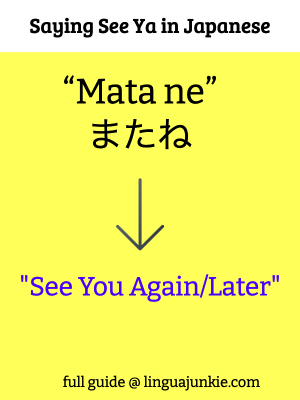
“Jā ne”
じゃあね
Or…
- “Jā matane”
- じゃあ またね
A slight variation on “mata ne” is “Jā ne”( じゃあね)or “Jā matane”(じゃあまたね).
“Jā” is casual form of “dewa” and it means “then”. These three phrases are basically the same. The sentence-ending particle “ne”( ね) makes the sentence or phrase sound slightly softer and more feminine. You can omit the ending particle “ne” ( ね) and just use the phrase as “Mata” (また)/“Jā” (じゃあ) /“Jā mata” (じゃあ また)as well.
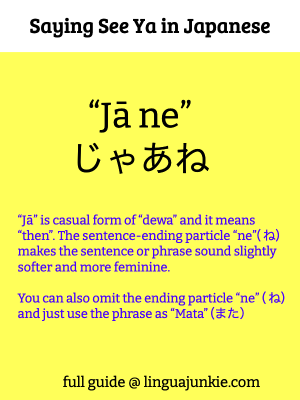
Reminder: You can also use these to say see you later in Japanese.
- Jā” じゃあ
- “Mata”また
- “Jā mata” じゃあ また
“Mata Atode”
また後で
“Mata Atode” (また後で)is another good choice when you are planning to meet your friends later on the same say.
“Ato” ( 後)means later, so the phrase literally translates as “ later again”.
It can mean anything from “see you later”, to “catch you later” or “ talk to you later.”
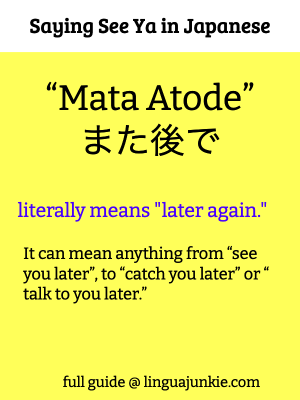
“Nochihodo”
後ほど
“Nochihodo” ( 後ほど)is polite form of “Mata Atode” (また後で), and it is an useful expression when you need to converse with someone superior to you or in a business setting.
In other words, you won’t be using this phrase with your friends and family.
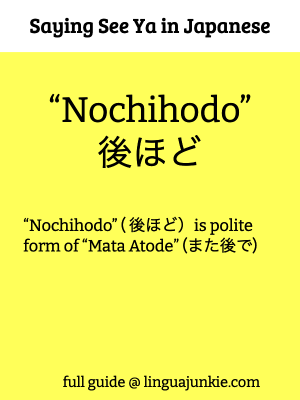
“Mata Ashita”
また明日
If you have concrete plans to see each other again the next day or when you know you are going to see this person again the following day, you can use “Mata Ashita” (また明日).
This can be translated as See you tomorrow in Japanese.
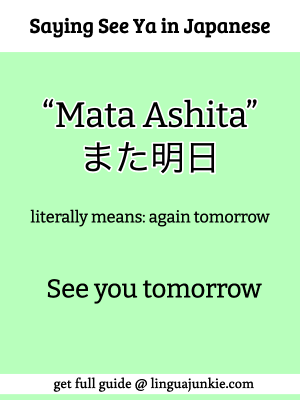
“Ashita” (明日)is the Japanese word for “tomorrow” and this phrase can be changed to whenever you see this person next. For example, using words like “Raishu” (来週), “Raigetsu” (来月), “Rainen”(来年), you can easily change phrases to similar ones.
- “Mata raishu” (また来週) means “see you next week”
- “Mata raigetsu”(また来月) means “see you next month”
- “Mata rainen”(また来年) is “see you next year”.
You can definitely try using “Mata rainen” before the New Year’s Holiday.
“Mata Aimashō”
また 会いましょう
This phrase is translated as “ Let’s meet again” or “Let’s see each other again.”

We have seen the word “`mata” (また)many times so far, so I won’t mention it here again…
“Aimasho” is a polite volitional form of the verb “to meet, to see” “Aimasu” (会います).
You can express your willingness to meet up again with this phrase. Using a previously mentioned word like “ashita”(明日)or “raishu”(来週), you can easily form the sentences like…
- “Let’s meet tomorrow” → “ ashita aimasho” (明日会いましょう)
- “Let’s meet up next week” → “raishu aimasho” (来週会いましょう)
Just being mindful of the context and honorifics, but using simple words as mentioned in this article, you can start conversing with native Japanese people.
Other Variations of See You Later in Japanese
So far, you’ve seen “mata” “ja” and “atode.”
Well, you can come up with a whole bunch of other variations to say see ya in Japanese.
- じゃ、後で。Ja, ato de.
- それじゃ、後で。Soreja, ato de.
- また後で。 Mata ato de.
- じゃ、また後で。 Ja, mata ato de.
- それじゃ、また後で。Soreja, mata ato de.
- 後でね。 Ato de ne.
- じゃ、後でね。 Ja, ato de ne.
- それじゃ、後でね。Soreja, ato de ne.
- また後でね。 Mata ato de ne.
- それじゃ、また後でね。 Soreja, mata ato de ne.
By the way, “ato de” means later. But as you can see, there’s quite a bit of variations involving “mata,” “ja,” “sore ja.” and “de wa.” Good to know. But no need to memorize them.
You get the point. They all mean pretty much similar things and trying to understand it would be like splitting hair. Again, nice to know but not too necessary.
How to Learn These Phrases
If you’re stressed about memorizing all these ways of saying see you later in Japanese…
Don’t be.
You don’t need to.
The most important parts of learning words and phrases are 1) getting acquainted (like you are doing now, perhaps), and 2) coming across them often, or repetition, until they’re firmly in your head.
The second part comes from actively learning Japanese with a program, Japanese textbooks, teacher or a class. (By the way, I can recommend a free course down below in the P.S. for anyone interested.) Oh, as well as constantly exposing yourself to the Japanese language helps.
So, if you are already doing that, then the words and phrases will come up again. So, you don’t need to memorize it all right now.
Conclusion
Now you how know to say see you later in Japanese.
The most common ones are ja ne and mata ne…
So, if you remember just ONE phrase from Linguajunkie (me), let it be one of those.
Sore ja.
– The Main Lingua Junkie
P.S. Interested in learning Japanese? This Japanese course for Absolute Beginners from JapanesePod101 is FREE for a limited time only. They plan to close it down in the future, but while it’s still open, give it a try. Click the image below.
